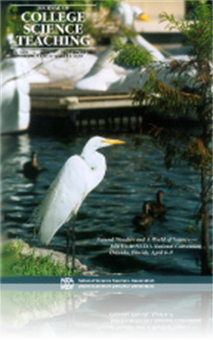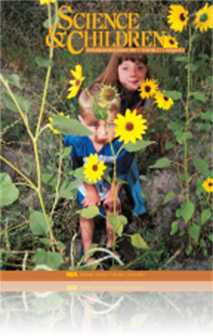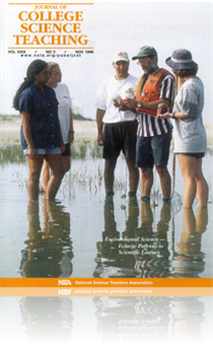All Resources
Journal Article
Why Do Students “Cook” Data? A Case Study on the Tenacity of Misconceptions
This paper describes an extraordinary example of data fabrication in which two students and their course instructor are so certain that they know how an experiment should turn out that they repeatedly dismiss contradictory data until they finally rep...
Journal Article
Guest Editorial: To Reweave a Rainbow—Reflections on the Unity of Knowledge
An opinion piece about the "Unity of Knowledge."...
Journal Article
Although Mendeleeff presented his periodic chart in a paper to the German Chemical Society in 1869, its acceptance was a gradual process. The changes in the chart and its movement to its present position inside the front cover of all texts is a perfe...
Journal Article
This exercise visually demonstrates that the binding of calcium to calmodulin changes its conformation to allow binding to a target protein, calcium/calmodulin protein kinase II. It introduces undergraduates to the concept of regulatory pathways cont...
Journal Article
This paper discusses how two different laboratory sections can employ nontraditional investigative laboratory modules that integrate concepts from cell biology, molecular genetics, and chemistry. During each module, students analyze data, draw conclu...
Journal Article
Studies in learning theory indicate that active learning is more effective than passive learning (Matthews, Cooper, Davidson, and Hawkes 1995; McKeachie 1980). Today’s students must be independent thinkers who can function well as team members. Lis...
Journal Article
http://World Wide Weather: Involving students in GLOBE's real-life scientific research
Students at Norwood School and more than 8,000 other schools on seven continents (including Antarctica) learn how scientific research works by participating in the GLOBE program (Global Learning and Observations to Benefit the Environment). Involving...
Journal Article
The scientific and technological issues surrounding environmental problems exemplify why teaching scientific literacy is so vital to environmental science courses. In this paper, the authors analyze some of the strategies that instructors of an envir...
Journal Article
The projects in this article focus on how a team approach can take advantage of the best of the Internet. To spread the word about these projects information is posted on teacher listservs, discussion areas, and Internet clearinghouses for online col...
Journal Article
Only rarely do teaching assistants (TAs) attend professional development workshops designed to acquaint them with pedagogical models. Thus, new instructors typically engage in ineffective instructional methods built on their experiences rather than o...
Journal Article
As we try to achieve the National Science Education Standards (National Research Council, 1996) and promote general science literacy for young children, we might begin by discussing conservation or stewardship. Children can readily understand the ide...
Journal Article
Editor's Note: It <b>Is</b> Exciting
Science and Children’s editor shares thoughts regarding the current issue and introduces NSTA's SciLINKS® connection....





